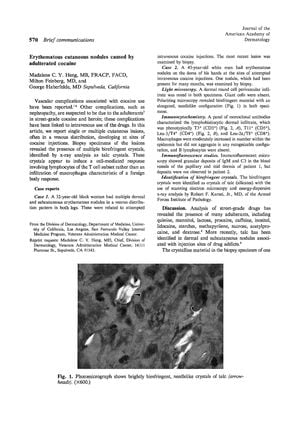Erythematous cutaneous nodules caused by adulterated cocaine
September 1989
in “
Journal of The American Academy of Dermatology
”
erythematous cutaneous nodules adulterated cocaine talc crystals cell-mediated immune response T lymphocytes immunocytochemistry T cell markers CD3+ CD5+ CD4+ CD8+ immunofluorescence IgM C3 hypersensitivity granulomas immune response foreign body reaction immunogenic talc granulomas skin nodules street-grade cocaine immune cells immune markers immune proteins

TLDR Talc in street cocaine can cause immune-reactive skin nodules where injected.
In the 1989 study, researchers reported on the development of erythematous cutaneous nodules in individuals who had injected adulterated cocaine. Two cases were presented: a 32-year-old woman and a 45-year-old man, both of whom developed nodules at the sites of cocaine injection. Biopsies of these nodules revealed birefringent talc crystals, which induced a cell-mediated immune response characterized by T lymphocytes rather than the macrophage infiltration typical of a foreign body response. Immunocytochemistry confirmed the presence of T cell markers (CD3+, CD5+, CD4+, and CD8+), and immunofluorescence showed granular deposits of IgM and C3 in the blood vessels of one patient. The study concluded that the talc crystals found in street-grade cocaine can lead to hypersensitivity granulomas, and the immune response to these crystals is enhanced rather than presenting as a typical foreign body reaction. The study also suggested that cocaine might directly enhance the immune response, contributing to the development of immunogenic talc granulomas.